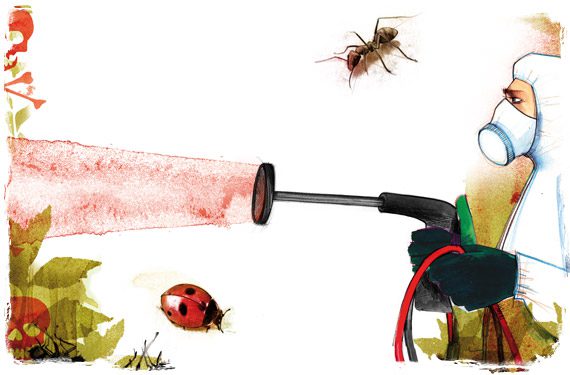The Science Behind Pest Control

The fight against pests is a centuries-old story, a constant battle between chaos and comfort. However, unlike our forefathers who fought with fire and brooms our modern-day counterparts have the most powerful weapon in our arsenal that is science. Don’t be fooled by bug zappers or mouse traps and dive into the intriguing world of pest control in which chemistry, biology and even physics combine to beat the six legged or greater adversaries.
Chemical Warfare: Precision Strikes on Tiny Foes
Insecticides, herbicides and rodenticides are the mainstay of pest control. And pest control dubai they always provides the best solution, chemical marvels that are targeted at specific biological processes inside the pest, causing disruption to neural functions, inhibiting reproduction, or making them dehydrated until they are gone. Imagine tiny missiles that target the weaknesses of your adversaries, and taking them out with brutal force. Pyrethroids resemble natural toxins in chrysanthemums, causing disruption to the signals that insects receive from their nerves. Glyphosate, a key ingredient in many herbicides interferes with photosynthesis, depriving the weeds of vital energy. Brodifacoum is a component of some rodenticides, can disrupt blood clotting which can cause internal hemorrhage. Like all weapons it is important to use it in a responsible manner. Understanding the particular pest’s biology and selecting the correct chemical is essential to ensure effectiveness and minimize environmental damage or beneficial insects.
Biological Blitzkrieg: Enlisting Nature’s Assassins
Have you seen ladybugs decimating the aphids’ army? It’s the natural pest control system working. Biological control techniques make use of the natural power of pathogens and predators to keep the pest population under control. Inviting lacewings into your garden could unleash destruction on the caterpillars. The tiny parasitic wasps lay eggs in beetle larvae making the insects into unreceptive nesting places for future generations of wasps. Bacteria such as Bacillus Thuringiensis (Bt) create poisons that can kill certain insects, acting as tiny snipers who slash their intended target. Although they aren’t always as swift as chemical control biological control is an environmentally sustainable and sustainable alternative that can lead to long-term pest control.
Physical Fortifications: Building Impregnable Barriers
Sometimes the most effective defense is an offense…or wall in this instance. Physical barriers such as screens, traps and nets stop insects from entering your property at all. Imagine your windows covered by an invisible field of force to ward off those pesky flies as well as mosquitoes. Mesh screens that cover drains and vents function as medieval portcullises that keep creatures that aren’t needed from your home while letting the air circulate. These traps are sticky and attract insects, and turn your house into an amusement park for the shrewd and uncoordinated. Physical methods aren’t guaranteed to remove existing pests, but they are a great initial line of defense and will significantly decrease the pressure of pests.
Technological Triumphs: High-Tech Solutions for a Low-Tech Problem
The arsenal of pest control doesn’t just consist of chemical products and animals. Technology is fast changing the game and offering novel solutions to our problems with pests. Ultrasonic technology emits high frequency noises that are unlistenable to humans, but are unbearable for certain insects. Pheromone traps attract insects with a symphony of scents that are irresistible and lead them to a impervious death. Heating treatments provide total pest elimination by literally cooking them alive. Think about it like an oven set-up to guests that aren’t invited. Drones that are equipped by thermal cameras will find hidden termite colonies that reveal the enemy’s secret caves, nests and tunnels. With the latest technology, we are constantly advancing our strategies for controlling pests to stay one step ahead of the constantly evolving creatures.
The Evolving Battleground: Adapting to a Cunning Enemy
As with the best villains Pests are constantly evolving becoming resistant to our biological and chemical weapons. This requires a flexible and strategic diversification of our approach to controlling pests. The rotation of different pesticides, with different methods of action can help in preventing the building of resistance. Combining multiple strategies, such as mixing chemical treatments with biological control agents, produces an array of strategies that are difficult for pests to defeat. Be aware of the latest trends in pest resistance and implementing an integrated approach to pest control (IPM) strategies is essential to long-term success.
Conclusion: Beyond the Battlefield, a Coexistence to Consider
Although the science behind pest control provides powerful ways to rid our homes from unwanted visitors It is important to keep in mind that the majority of pests aren’t enemies. Certain species play crucial roles in our natural ecosystems so a complete elimination is not always feasible and can be ecologically disruptive. The aim should be to achieve an equilibrium, limiting the population of pests to a manageable level while minimizing damage to other living things and the natural environment. Through being aware of the intricate interplay of life in our ecosystems and implementing science-based effective, sustainable methods for controlling pests and techniques, we can achieve an environment in which people and creepy crawlies be part of the same planet, but with clear boundaries.




